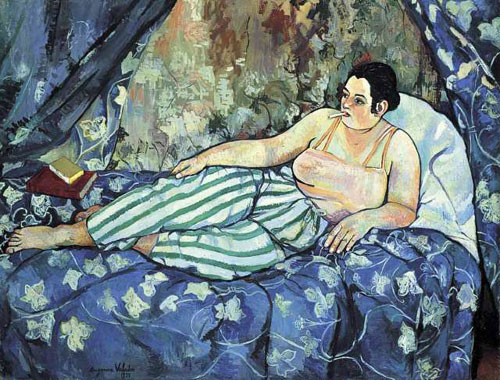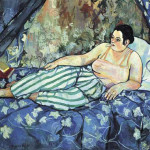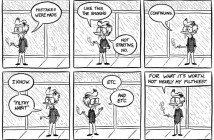ROUNDTABLE
Roundtable is a new feature where the staff at Big RED & Shiny respond to questions that are pertinent to the art world, simply on our minds, or have been nagging us. We share the questions with each other and simply write a response. In addition, we feel this is a perfect way to hear from you. If you want to comment and add to the discussion, please do. Or better yet, write us with a Question you would like us to discuss in the future.
The first Roundtable appeared in issue #106.
Q: The Pompidou Center recently put all their males in storage and will exhibit only women from the collection for the next year. Do you see this curatorial action as "a revolutionary gesture of affirmative action", as they claim, or something else? What type of effect might this have for historical readings of women?
MJM: Despite the problems it might have, i.e. trying to correct a historical problem that is not correctable, overcompensation that could read as pandering, inclusion for the sake of inclusion, etc, I love the idea. The exhibition is coming off several major traveling exhibitions tracing the origins of feminism in art so the timing makes sense. I doubt it will get much controversy. However, what I admire about the gesture has more to do with museum purchasing than it does feminism. I like the idea that exhibitions of holdings could frequently be only women, or who bought what from whom (and on whose advice), or by subject instead of time period, like the MOMA did a number of years ago in “Making Choices”, or maybe something even more arbitrary like the size of a painting. I’d love to see the MFA fill a room with every canvas they own that measures 72” x 96”. This type of designating is a more ambitious method of exhibiting work, more conducive with engaging an audience with what has been bought, and what it might mean, rather than being told what is important.
JN: I'm not sure if this concept is a "revolutionary gesture of affirmative action." That statement in and of itself is awfully problematic. However, I think this is an interesting idea and I am curious to see how it unfolds. What will they pull from their collection is the big question? And will these exhibitions be read against the work they have shown of male artists? I am really wondering though if this will backfire against them. Wouldn't it be best to really integrate female artists into the collection on view? Is this just another way of relegating female artists to the sidelines? Will the standard operating procedures return once the year is over? I like the questions this plan raises.
CH: A brief note before I get started: The fact that Big RED is taking up a question like this may elicit pause from some (We are based in a city that has more female successful artists than male successful artists. Our editorial staff is 100% men).
This "gesture" is not "affirmative action," nor is it "revolutionary." It is a narcissistic and impotent gesture, not unlike the stereotype for student activism. The Centre Pompidou's curatorial design is, at best, a grotesque interpretation of affirmative action. It does not pass a basic test for affirmative action, a test that was formulated by the US Supreme Court, that has lead to the practice of more nuanced and complex forms of affirmative action in the US: it is not "narrowly tailored." The Pompidou's curatorial practice has de-individualized the artists they are showing, making the artists merely women (or perhaps, given their low percentage of female-created works (17%), one could even say "merely non-male"). If the Pompidou wants a revolutionary show in terms of gender, they might want to consider specific attributes of individual female artists and ask specific questions about their identity: e.g. was this woman artist brought up in a supportive, wealthy and liberal family? or did she need to overcome repressive cultural values and institutional bias in order to create her work? Art is made by individuals, not by genders. If the show took a more scholarly rigorous approach to the overcoming of male domination in art, the Pompidou would have a more effective show. The importance of intellectually challenging your viewers with exhibitions that seek to upset traditional roles and perceptions cannot be underestimated.
How about buying only art made by female artists until their collection reaches gender parity? Well, if they carried through such a policy, they'd invariably miss the chance to acquire many historically important works in the same way as what would happen if they only acquired works by men, Western or white artists. (This is why AF policies must be "narrowly tailored.")
The Pompidou says that 17% of its collection is by female artists (they'll be exhibiting about 25% of that number in the show: ~213), and we should commend them for admitting such an embarrassing statistic. We are all aware that the Pompidou's collection does not represent the gender split of the artistic population now nor has it ever. The fact that there are cities like Boston, where women dominate the art scene (Go Boston!), shows that "Contemporary" and "Modern" art institutions have been lumbering down the well warn paths to the male-dominated commercial art marketplace since its inception.
Showing only female-created art will yield an interesting demonstration, however, of both the weaknesses of the Pompidou's own curating and the inability of Contemporary art to bring about palpable social evolution. Though the show is intellectually hebetating, looking past its gimmick will hopefully tell us something new.
MN: What I found interesting about this concept was the possibility of a re-imagining of how museums ascribe relevance and value to work. This show, comprised of work by women artists, seems to put artistic intention, quality, context, and other important concerns on a second tier, below the gender of the artist. As a strategy for deconstructing curatorial premises, this could produce a number of fascinating shows. Imagine an exhibition of all male artists, not based in the incidental mode of art history where men are generally lionized, but a show where the goal was to highlight the quintessential "maleness" of the art. What would it look like? Would it reduce itself to a macho-man mentality, or would it be more heroic, more virile, more emotionally distant?
One could extend this idea outward in a number of ways, each equally ridiculous. Only art by single women, gay men, artists whose father was from Kenya who were raised in Hawaii, artists whose parents were famous, artists who grew up in New Jersey... would any of these hyperspecific background traits be found in the work? I think The Pompidou Center is trying to look at art history in a new way with this exhibition, which I applaud, but I'm not sure this show tells us anything we didn't already know about art history and its very flawed relationship to women artists.
- Suzanne Valadon, La Chambre bleue, oil canvas, 1923. Part of the Centre Pompidou’s “elles@centrepompidou,” that will feature hundreds of works by female artists only.
"At Paris' Pompidou Center, the year of the women" in the Los Angeles Times
Image via the L.A. Times website.





